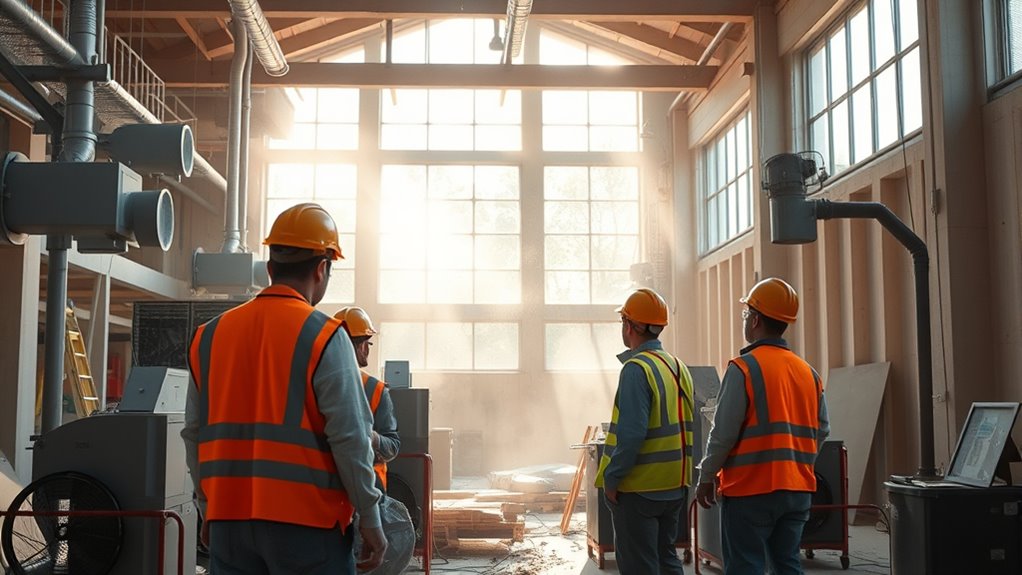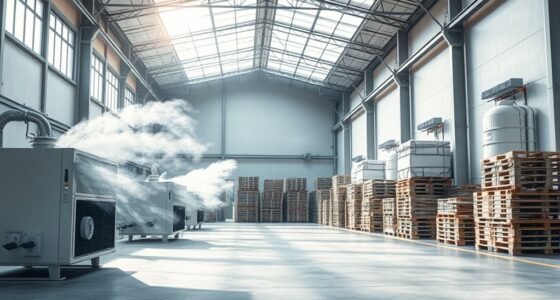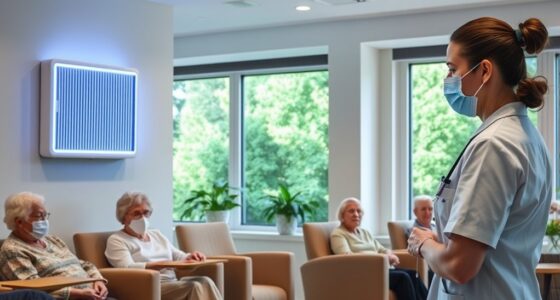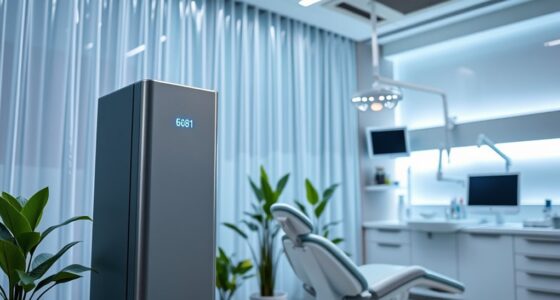To effectively manage IAQ during construction or renovation, monitor pollutant levels in real time with portable air quality devices to identify hazards promptly. Use proper ventilation, including local exhaust systems and natural airflow when possible, to dilute airborne contaminants. Coordinate monitoring with your construction activities, increasing ventilation or stopping work during high-pollution tasks. Consistent measures like these protect health, ensure compliance, and create safer environments—discover more strategies to keep your site safe and compliant.
Key Takeaways
- Implement continuous IAQ monitoring with portable devices to detect dust, VOCs, and hazardous gases in real-time.
- Use targeted ventilation strategies, including local exhausts and air filtration systems, to reduce airborne pollutants.
- Coordinate IAQ management with construction schedules, increasing ventilation or halting work during high-pollution activities.
- Ensure proper maintenance of ventilation systems, including HEPA filters, for optimal pollutant removal.
- Promote communication and signage to inform workers about air quality conditions and safety measures.
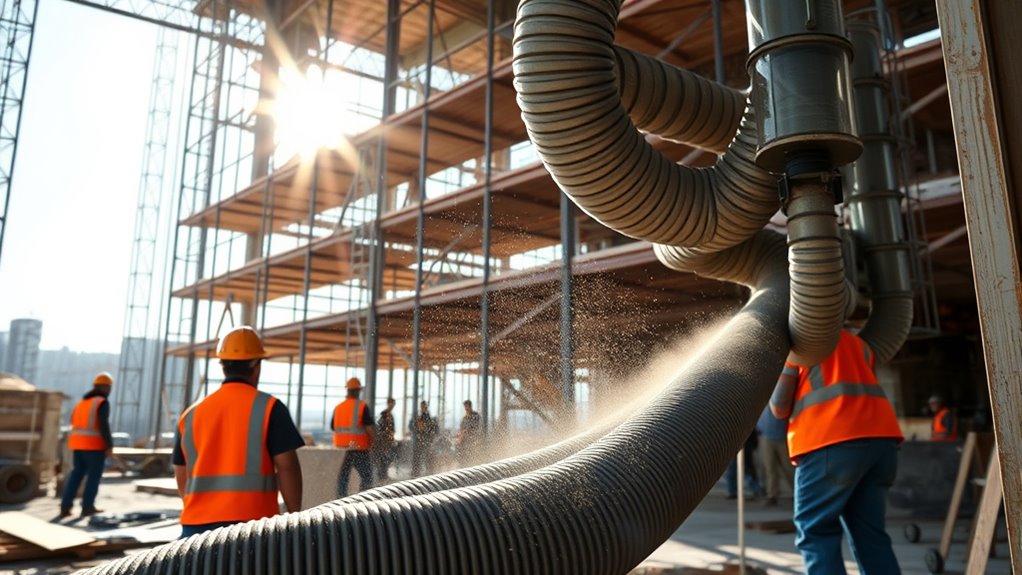
Managing indoor air quality (IAQ) during construction and renovation projects is essential to protect workers and future occupants from harmful pollutants. Construction sites often generate dust, fumes, volatile organic compounds (VOCs), and other airborne contaminants that can pose serious health risks if not properly managed. To effectively control these hazards, you need to implement robust air quality monitoring systems and well-planned ventilation strategies. Air quality monitoring allows you to continuously assess pollutant levels in real-time, giving you immediate data to identify when airborne contaminants reach unsafe thresholds. This ongoing surveillance helps you make informed decisions, such as increasing ventilation or pausing work in specific areas until air quality improves. You should use portable air quality monitors that can detect dust particles, VOCs, carbon monoxide, and other hazardous gases. These devices are easy to deploy across different zones of the site, providing a comprehensive picture of IAQ conditions throughout the project timeline.
Implementing emotional support measures for workers during high-stress periods can also improve overall safety and morale. Ventilation strategies are equally essential in maintaining safe indoor air environments during construction activities. Proper ventilation helps dilute and remove airborne pollutants, reducing exposure for workers and future occupants. You need to design your ventilation approach based on the specific pollutants generated and the layout of the site. Local exhaust systems can be employed near dust-generating tasks, such as cutting or sanding, to capture contaminants at their source. Additionally, natural ventilation, such as opening windows and doors, can be effective when weather permits, promoting airflow and dispersing accumulated pollutants. Mechanical ventilation systems, including exhaust fans and air filtration units, are essential for maintaining consistent air exchanges, especially in enclosed spaces. These systems should be regularly inspected and maintained to guarantee they operate at peak efficiency. Incorporating high-efficiency particulate air (HEPA) filters into ventilation systems can trap fine dust and other airborne particles, preventing them from recirculating within the environment.
It’s also essential to coordinate your air quality monitoring and ventilation efforts with your construction schedule. For example, during high-pollution tasks, you might need to increase ventilation or temporarily halt work if air quality dips below acceptable levels. Proper signage and communication with workers about IAQ conditions help guarantee everyone stays aware of potential hazards and follows safety protocols. By integrating continuous air quality monitoring with targeted ventilation strategies, you can considerably reduce health risks and create a safer environment during construction and renovation projects. This proactive approach not only safeguards health but also ensures compliance with occupational safety standards, ultimately leading to smoother project execution and healthier indoor environments upon completion.
Frequently Asked Questions
How Do Weather Conditions Affect IAQ Management Strategies?
Weather conditions considerably impact your IAQ management strategies. Climate variability means you need to adapt your ventilation and filtration methods to changing temperatures and humidity levels. Seasonal adjustments are essential, such as increasing ventilation during humid months to reduce moisture buildup or sealing gaps during cold weather to prevent drafts. By staying flexible and monitoring weather forecasts, you can effectively maintain good indoor air quality regardless of external conditions.
What Are the Costs Associated With IAQ Control Measures?
You’ll find that IAQ control measures come with costs like equipment, materials, and labor. Conducting a thorough cost analysis helps you identify expenses and prioritize effective strategies. Including these costs in your budget planning guarantees you allocate sufficient funds for ventilation, air filtration, and moisture control. By understanding the financial impact upfront, you can implement IAQ controls efficiently and avoid unexpected expenses during your project.
How Can Workers’ Health Be Monitored During Construction?
You can monitor workers’ health effectively by implementing regular occupational health check-ups and real-time air quality monitoring. Did you know, poor indoor air quality can increase respiratory issues by up to 30%? Use air quality sensors to detect pollutants instantly, and schedule health assessments to catch symptoms early. This proactive approach assists in safeguarding your team, reduces health risks, and ensures a safer, healthier construction environment.
Are There Specific Regulations for IAQ in Different Regions?
Yes, regional standards and regulatory compliance shape IAQ regulations across different regions. You should check local, state, or national guidelines to guarantee you’re meeting specific requirements. These regulations often specify permissible pollutant levels, ventilation standards, and inspection protocols. By understanding and adhering to regional standards, you help protect workers’ health and ensure your project remains compliant with legal obligations. Always stay updated on regional regulation changes to maintain best practices.
How to Handle Unexpected IAQ Issues During Ongoing Projects?
Did you know that poor IAQ causes over 4 million deaths annually worldwide? When unexpected IAQ issues arise, you should act quickly. Use air quality sensors to detect pollutants and implement effective ventilation strategies immediately. Regular monitoring helps identify problems early, allowing you to adapt ventilation and reduce risks. Staying proactive with these tools guarantees a safer environment, even when surprises occur during your project.
Conclusion
Think of managing IAQ in construction and renovations as tending a delicate garden. If you nurture with careful planning, control dust, and make certain of proper ventilation, your project’s environment flourishes—safe and healthy. Neglect these steps, and pollutants could overrun your space like weeds, causing harm. By staying vigilant and proactive, you become the gardener of your site’s air quality, cultivating a safe haven where both workers and future occupants can thrive. Your attention ensures a healthy, vibrant space to grow.
